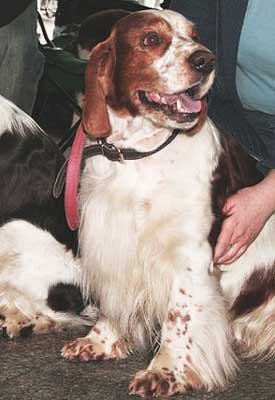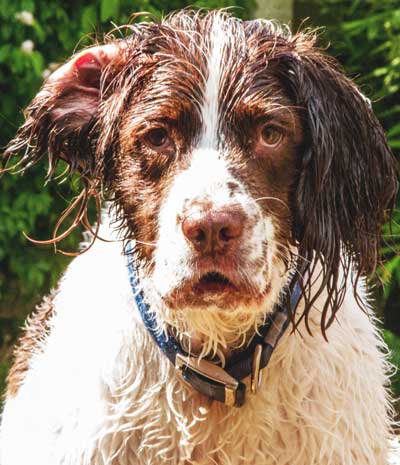The Springer Spaniel is a beloved breed of dog that originated in England and has been around for centuries. They are known for their cheerful, friendly temperaments and beautiful coats that come in liver and white, black and white, and tri-color varieties. The tri color Springer Spaniel is one of the rarest color varieties of the popular breed. They have three colors in their coat – brown, white and black or dark brown.
Springer Spaniels have an amazing sense of smell which makes them exceptional hunting dogs, as they can track down prey with ease. As family pets they are often seen as loving, devoted companions who are eager to please their owners.
This breed has a strong work ethic and loves keeping busy — whether it’s tracking birds in the field or leaping through agility courses at home.
Springer Spaniels make great playmates for children and love being part of the family — they even get along well with other household pets like cats! While they are good watchdogs, they tend to bark less than other breeds because of their laid-back nature.
Springer Spaniels have an average lifespan of 10 to 14 years when given plenty of exercise, proper nutrition, and preventative health care. Their thick coats require regular brushing to avoid matting so if you adopt a spaniel make sure you’re prepared for some time dedicated to grooming!
This breed isn’t prone to many illnesses but may suffer from hip dysplasia or eye issues — speak with a vet about getting your pet tested for these conditions early on so you can manage them accordingly.

History and origin of the Tri-Color Springer Spaniel
The origins of this color Springer Spaniel still a bit of a mystery, however it is believed that they were developed in the 1880’s when breeders attempted to combine the characteristics of two other breeds. The combination resulted in the Tri-Color Spaniel — an intelligent and loyal companion with striking good looks!
Springer Spaniels are often used as therapy dogs because of their gentle nature and people-pleasing personalities, which make them well-suited for interacting with both children and adults.
If you’re looking for a pup who will be devoted to you and your family for years to come, consider getting a Springer Spaniel in any of the colors — you won’t regret it!
Why do tri-color spaniels exist and should you get one?
Tri-color spaniels have been around for centuries. They are a product of careful breeding practices used to create a distinct, colorful variety of the beloved spaniel breed. Many pet owners find that tri-color spaniels make wonderful companions due to their loyal and affectionate natures.
Whether or not you should get one is entirely up to you and your lifestyle preferences. Tri-color spaniels may be the perfect fit if you want an intelligent and playful pup who enjoys being outdoors as much as being snuggled inside. However, these dogs require regular grooming, lots of attention, training, and plenty of exercise for these springer spaniels in order to stay healthy and happy.
If you don’t think you can commit to the necessary care and exercise, you may want to consider a different breed of dog.
Overall, tri-color spaniels are beautiful, lovable dogs that make great companions for those willing to invest the time and energy needed to keep them happy and healthy. If you’re looking for a loyal pup who loves being around people and exploring nature, then a tri-color spaniel might be the perfect choice.
Caring for a Three Color Springer Spaniel
The Springer Spaniel has a thick, luxurious coat in a variety of colors that requires regular maintenance. They shed a lot. And Springer spaniels aren’t suitable for allergy sufferers. Without proper grooming, mats can form in thick areas like the chest, around the legs and ears, and on the tail.
To keep your dog’s coat looking beautiful, it’s important to brush them at least once a week to remove dead hair and reduce shedding. It’s also important to give the coat a deep clean every few months to prevent dirt and debris from building up in their fur. In addition to brushing, you’ll need to bathe your Springer Spaniel regularly as well.
Bathing should be done every four to six weeks with a specialized dog shampoo for your spaniel’s tri color fur — make sure you use one that is specifically formulated for dogs so it won’t irritate their skin or strip away natural oils from their coat. After each bath, use a gentle conditioner that is free of harsh chemicals and fragrances. This will help moisturize their skin, reduce static electricity, and protect them from harmful UV rays.
To complete your dog’s grooming routine, trim their nails every couple of weeks or when they become long enough for them to start clicking against the floor when they walk. A good nail trimmer is key here; if you don’t have experience with this type of grooming, take your pup to a professional groomer who can ensure they get a safe trimmings without any pain or discomfort.
Finally, check your dog’s ears once every two weeks for signs of infection like redness or discharge. Cleaning them with an ear-cleaning solution designed specifically for dogs will help keep your pet healthy and minimize any potential problems down the line.
By taking proper care of your Tri-Color Springer Spaniel’s coat and other grooming needs, you can ensure they look their best while also keeping them healthy! Be sure to consult your vet if you have any questions about how often you should groom them or what products are best for their specific needs. With just a little bit of effort each day, you can keep your pup looking great for years to come!

The Tri-Color Springer Spaniel is an active breed that requires a nutrient-rich diet formulated for their size and age. A balanced meal should provide about 30 percent protein, 10 to 15 percent fat, and 45 to 50 percent carbohydrates.
High-quality proteins such as chicken, beef, fish, and eggs should be included in the diet as they are essential for muscle development and support healthy joints. Fruits and vegetables like apples, carrots, squash, sweet potatoes, and spinach are good sources of vitamins and minerals as well as dietary fiber which supports digestion.
Additionally, essential fatty acids like Omega 3s should be present in their diet in order to promote healthy skin and coat while also providing immunity benefits. These can be found in fish oil or other supplements specifically designed for dogs. It’s important to avoid too much fat or starch in your pet’s diet as it can lead to obesity which can put unnecessary strain on their joints and cause other health issues.
When feeding your Springer Spaniel puppy, make sure you use a food specially made for puppies that is rich in calcium and phosphorus to help them grow strong bones and teeth.
Puppies have higher energy needs than adult dogs so look for foods with more calories than adult dog food — this will ensure they get the nutrition they need without overeating. Once your pup reaches maturity (at about 12 months old) you can switch them over to an adult dog food which may have fewer calories but still has all the nutrients necessary for good health.
It’s important to feed your Springer Spaniel small meals throughout the day rather than one large meal since their stomach is smaller compared to larger breeds of dog. Make sure you always provide fresh water after meals — this helps flush toxins from the body while keeping them hydrated as well! Lastly, avoid giving table scraps as these can upset your pup’s digestive system or even cause them to become overweight if given too often.
By following these guidelines when it comes to diet and nutrition you can keep your Tri-Color Springer Spaniel happy and healthy! Remember that every dog is unique so always consult with your veterinarian if you have any questions or concerns regarding feeding habits or specific nutritional requirements.
4 Tips for training an English Springer Spaniel
1. Start training early and be consistent: English Springer Spaniels respond best to consistent, positive reinforcement techniques. Starting training as soon as possible will help your pup learn good habits from the beginning and make it easier for them to understand what is expected of them in different situations.
2. Socialize with other dogs: Exposure to a variety of people and animals helps your pet become comfortable around new sights, smells, sounds, etc., which can go a long way in preventing aggressive behaviors down the road. Enrolling your pup in puppy classes or dog parks are great ways to socialize!
3. Use treats and rewards: Rewarding good behavior with verbal praise or treats can help strengthen the bond between you and your pet while also reinforcing desired behaviors like sitting/staying on command or coming when called.
4. Exercise regularly: Regular exercise is important for all breeds but especially so for active breeds such as English Springer Spaniels! Daily walks or jogs are a great way to give your pup some much-needed physical activity while also providing mental stimulation through exploring new surroundings together — just be sure not to overexert yourself if you’re unfamiliar with handling large breeds!
Health conditions that can affect triple-colored Spaniels
English Springer Spaniels are a large breed of dog with an active personality and high energy requirements. As with any breed, they can be prone to certain health concerns that owners should be aware of. One such example is Springer Spaniel rage for instance.
One issue is hip dysplasia, which is a genetic condition characterized by abnormal development of the hip joint. This can cause pain and lameness in the hind legs as well as other symptoms such as difficulty rising from a resting position or hopping instead of running. It’s important for owners to know the signs so that early intervention may be possible to help minimize the effects of this condition on their pet’s life.
Eye problems can also develop in English Springer Spaniels, particularly cataracts which cause a cloudy appearance in one or both eyes. These can occur due to genetics, age, or injury and require medical treatment if left untreated could lead to vision loss. Other eye problems include entropion where eyelids roll inward causing discomfort; distichiasis where extra eyelashes grow abnormally; and progressive retinal atrophy (PRA) which causes deterioration of the retina over time.
The breed is also prone to ear infections which can be painful and cause hearing loss if left untreated. Since they have long ears that hang down close to their face, they are more likely than other breeds to get ear infections due to trapped moisture and debris inside the ear canal.
Regular cleaning by an experienced groomer or vet tech can help reduce this risk — however if you notice your pet has chronic ear infections it may be worth visiting your vet for an exam and further testing as this may indicate a deeper underlying problem like allergies or immune system issues.
Finally, English Springer Spaniels are at risk for patellar luxation — a misalignment of the kneecap — as well as allergies which manifest differently depending on whether they’re allergic to food, pollen, molds etc., and epilepsy, although this latter condition is relatively rare in dogs overall.
By being vigilant about potential health concerns associated with English Springer Spaniels owners can ensure their pet lives a healthy happy life! Regular visits to your veterinarian for check-ups will allow them to diagnose any issues early on before they become serious so don’t hesitate to book an appointment if you suspect something might be wrong with your pup!